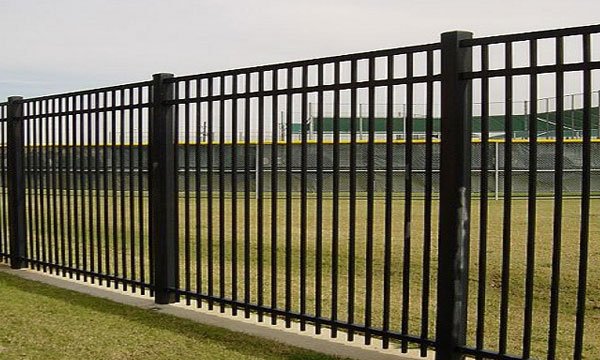How to Maintain Your Iron Fence After Installation?
Discover how to maintain your iron fence after installation with tips on cleaning, rust prevention, painting, and regular inspections for long-lasting durability.

Iron fences are very popular due to their strength, durability, and elegance, but, like any outdoor feature, they need regular care to stay in good condition. These include scheduled checks every three months for rust, loose components, and damage. The fence should be cleaned bi-annually to remove debris, protect it against moisture, and apply lubrication to moving parts. Any damage should be addressed promptly, and protective coatings should be reapplied every 2-3 years for maximum longevity and prevention of rust accumulation.
Tips for Maintaining Iron Fence After Installation
Here are some tips that all property owners should follow:
Inspect Your Fence Regularly
Regular inspections are the foundation of proper iron fence maintenance. Walk along the length of your fence at least once every three months to check for signs of damage, rust, or loose components. Look out for:
-
Rust spots or discoloration.
-
Loose screws, bolts, or hinges.
-
Cracks in the paint or coating.
-
Bent or broken sections of the fence.
By catching these issues early, you can address them before they worsen, saving you time and money in the long run.
Clean the Fence Thoroughly
Cleaning your iron fence will remove grime, dirt, and debris that could help reduce the damage you don't see. Here's how to clean it:
-
Materials Needed: Soft brush, warm, soapy water, and a garden hose.
Steps
-
Use a soft-bristled brush to clean the dirt and grime off the fence.
-
Rinse it thoroughly with the garden hose. This will make sure soap suds are not left behind on the fence.
-
Dry the fence using a cloth or air drying.
-
You should clean at least twice a year if your fence is subject to extreme weather or pollution.
Prevent Rust Formation
Rust is one of the biggest threats to an iron fence. It makes the fence look dull and unpresentable, ruining its structure in the long run. The ways to avoid rust:
-
Apply a Rust-Inhibiting Primer: Paint the installed fence with a rust-inhibiting primer.
-
Use Protective Paint: The high-quality paint prevents rust from occurring by stopping the access of moisture and oxygen.
-
Touch-Up Paint Regularly: If you notice chips or cracks in the paint, apply touch paint to prevent exposure to the elements.
If rust has already appeared, sand the affected areas with fine-grit sandpaper, then apply primer and repaint.
Lubricate Moving Parts
If your iron fence has gates or other moving parts, lubrication is essential to keep them running smoothly. To prevent squeaking and stiffness, use a silicone-based or graphite lubricant on hinges, latches, and locks. Apply lubricant every 3-6 months or as needed.
Protect Against Moisture
Moisture is one of the major contributors to rust and corrosion in iron fences. Although high-quality paint and primer provide protection, there are additional measures that can be taken:
-
Ensure the area around the fence is well-drained so that water does not collect at its bottom.
-
Cut grass and other vegetation close to the fence to minimize moisture accumulation.
-
Cover the fence with a tarp during heavy rain or snow.
Address Damage Promptly
Don't ignore even minor damage to your fence. Bigger problems may arise if you notice bent sections, loose screws, or other issues:
-
Bend the damaged parts with pliers or a rubber mallet.
-
Replace loose bolts and screws with a wrench or screwdriver.
-
For larger issues like dents or breaks, it's best to consult a professional iron fence installers.
Reapply Protective Coatings
The protective coatings on your iron fence will gradually wear off with time due to weather and general wear and tear. Reapply every 2-3 years to maintain the integrity and appearance of the fence. Begin with a rust-inhibiting primer and durable outdoor paint for metal surfaces.
Winterize Your Fence
Iron fences wear out most during winter, especially for those in areas that experience freezing, snow, ice, etc. Prepare your fence for winter by:
-
Clean it properly before the first frost.
-
Apply a new layer of protective paint or sealant.
-
Removing snow and ice accumulation promptly to avoid moisture damage.
These processes will reduce the chances of rust and damage when the weather becomes cold.
Trim Nearby Vegetation
Vegetation around your iron fence, such as overgrown plants, vines, and shrubs, can trap moisture near the fence and accelerate rust and corrosion. Trim them back to reduce water retention and allow air to flow around the fence.
What Conditions Affect The Longevity Of Your Iron Fence?
Some factors that determine the longevity of your iron fence include:
-
Rust and corrosion due to harsh weather conditions such as rain, snow, and high humidity.
-
Deterioration due to dirt, grime, or rust can be prevented through regular cleaning, painting, and rust removal.
-
High-quality iron and protective coatings increase durability.
-
Well-constructed joints and welds ensure structural integrity.
-
Do not hang heavy items on the fence, which will cause bending or damage.
-
Keep plants and shrubs away to reduce moisture retention and potential damage.
Conclusion
Maintaining your iron fence after installation is crucial for its longevity and appearance. Regular inspections, thorough cleaning, and prompt repairs prevent rust and damage. Utilizing high-quality coatings and protective paint enhances durability while managing moisture and vegetation prevents corrosion. By adhering to these practices, you can ensure your iron fence remains attractive and functional for years.
What's Your Reaction?
















